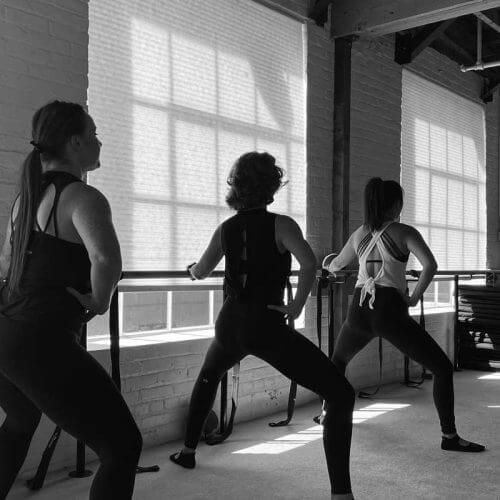Why Dance Barre Height and Material Matter for Performance
04/01/2025 3:00pm

Imagine you're in the middle of a plié sequence, focusing on your turnout and balance. But instead of feeling strong and steady, your hand keeps slipping on the dance barre, or your shoulder feels strained from reaching too high or too low. Frustrating, right?
Even the most refined technique can suffer without the right equipment. Your barre should support your training—not stand in your way. Small details, like height and material, can transform your entire movement experience.
It's easy to overlook the details of barre height and material, but these factors have a big impact on your technique, comfort, and overall performance. The right barre setup helps you refine your form, prevent injuries, and improve strength.
So, does barre height and material really matter? Absolutely. Let's explore why these factors are more important than you might think - and how finding the perfect barré can elevate your training.
Proper Alignment and Posture
1. Proper Alignment and Posture
The height of a dance barre directly affects your body alignment and muscle engagement. A barre that is too high forces your shoulders to lift, creating tension in your neck and upper back. A barre that is too low can cause you to hunch over, which affects your balance and core activation.
The general guideline for barre height is 35 to 42 inches from the floor, but this isn't a one-size-fits-all solution. Taller dancers often need a higher barre, while shorter dancers perform better with a lower setup.
Many professional studios install double barres at different heights to accommodate dancers of varying statures. For home use, adjustable barres give you the flexibility to customize the height to match your body and training style.
2. Impact on Muscle Engagement
Correct barre height encourages proper muscle engagement during exercises like pliés, tendus, and développés. When your hand rests comfortably on the barre at elbow height, your shoulder blades stay relaxed, and your core remains engaged.
A barre that is too high can overactivate your traps, restricting movement and leading to fatigue. A barre that is too low reduces support for your standing left, causing instability during leg extensions and balance work.
Customizing your dance barre height helps you engage the right muscle groups without strain - improving both strength and technique.
How Dance Barre Material Influences Performance
1. Grip and Comfort Differences
The material of a dance barre influences how your hands group and how much resistance you feel during exercises.
- Wood Barres - Traditional wooden barres (like ash, oak, and maple) offer a natural grip. Wood also retains warmth, which helps prevent slipping due to sweat.
- Aluminum Barres - Aluminum barres have a sleek, modern feel and are highly durable.
Professional dancers often prefer wood for its natural grip and warmth, while aluminum is popular in fitness studios for its contemporary look and easy maintenance.
2. Stability vs. Flexibility
Different materials also provide varying levels of stability and resistance.
- Wooden barres allow for more natural muscle engagement and reduce joint strain during stretches and resistance exercises.
- Aluminum barres are beneficial for strength-based barre workouts.
Choosing the right dance barre material ensures that your body feels supported and aligned during training.
Customizing Your Dance Barre for Your Body
Height Adjustability
Adjustable barres are ideal for home use because they allow you to customize the height to match your body type and training needs.
For taller dancers, a higher barre provides better support for leg extensions and balance work. Shorter dancers benefit from a lower barre that keeps their shoulders relaxed and their core engaged without overreaching.
VITA Barre offers adjustable options, allowing you to tailor the height to fit your body and training style. This flexibility is especially valuable when multiple people are sharing a barre.
Studio vs. Home Dance Barre Setup
1. Fixed Studio Barres
In professional studios, fixed barres are often installed at a standard height to accommodate group classes. This means some dancers may need to adjust their hand placement or stance to compensate for less-than-ideal height.
Studios with double barrés allow dancers to select the height that best suits their body type and training goals.
2. Home Dance Barres
When training at home, having a custom or adjustable dance barre makes a big difference. Freestanding barres are ideal for flexibility since they can be moved to different rooms or outdoor spaces. Wall-mounted barres offer greater stability for balance work and strength training.
Why It Matters
So, does dance barre height and material really matter? Yes - more than you might think. The right dance barre height encourages better alignment, improved muscle engagement, and reduced injury risk. The material influences how secure and comfortable you feel during training.
A well-positioned barre helps you maintain proper posture and engage the right muscles without strain. A secure grip on a high-quality barre allows you to focus on refining your technique rather than adjusting your stance or grip.
For professional studios, offering adjustable or double barres creates an inclusive environment for dancers of different heights and training styles. For home training, investing in a custom barre allows you to create a personalized setup that supports your body and your goals.
Final Thoughts
Finding the right dance barre is about more than convenience - it's about optimizing your performance and protecting your body. Whether you prefer the warmth and grip of wood or the sleek stability of aluminum, VITA barre offers a range of customizable options designed to elevate your training experience.
A properly fitted barré supports your alignment, strengthens your muscle engagement, and helps you train with greater confidence. When your barre feels like an extension of your body, you can focus on refining your technique and unlocking your potential. Choosing the right barre enhances your technique, comfort, and overall performance.



